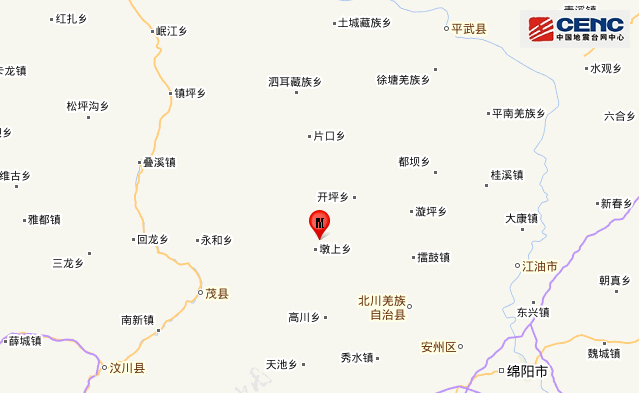Two quakes rattle county in Sichuan


Magnitude 3.6 and 3 temblors hit area on Sunday, the 6th and 7th in five days
Two earthquakes, one of magnitude 3.6 and the other magnitude 3, jolted Beichuan Qiang autonomous county in Mianyang, Sichuan province, on Sunday morning, the sixth and seventh in a string of quakes in the county since Wednesday.
The larger of the two earthquakes struck at 2:04 am, with the smaller one at 11:45 am.
The China Earthquake Networks Center said the magnitude 3 quake originated at a depth of 18 kilometers. No deaths or injuries were reported in any of the quakes.
A magnitude 4.6 earthquake occurred in Beichuan at 12:04 pm on Wednesday at a depth of 17 km, then a magnitude 4.7 earthquake shook the county at 11:03 am on Thursday.
Nineteen firefighters in three trucks from Mianyang, the city that oversees Beichuan, rushed to the epicenter but ultimately returned because the quake was not catastrophic, the team said.
Experts from the China Earthquake Networks Center said comprehensive research showed that two quakes on Wednesday and Thursday were normal vertical activities of land after the catastrophic earthquake in Wenchuan in 2008.
Three quakes, with magnitudes of 3, 2.8 and 3, took place on Friday.
As Beichuan is located in the Longmenshan Seismic Belt, it is not unusual for a string of quakes to occur there, said Wang Tun, director of the Institute of Care-Life in Chengdu.
He ruled out the possibility that the seven quakes were the prelude to a major quake.
The probability that a devastating earthquake would happen in Beichuan is minimal as most of the underground stress had been released by the Wenchuan earthquake, Wang said.
With its largely mountainous terrain, Sichuan is prone to frequent earthquakes. A magnitude 8 temblor centered in Yingxiu town, Wenchuan county, on May 12,2008, killed more than 69,000 people.
Beichuan was hit hardest by that quake.
Ten days later, Deng Changwen, a spokesman for the Sichuan Earthquake Administration, said that more than 7,000 Beichuan residents had perished.
As houses in the Wenchuan earthquake zone, including Beichuan, have been rebuilt and can resist powerful quakes, people in the county do not need to panic, Wang said.
A real-time earthquake early warning system has been installed on TV sets and mobile phones in Beichuan, and residents can use it to save themselves from earthquakes, he said.
The system provides warnings seconds after a quake and can save lives because the warnings are transmitted via radio waves that travel much faster than seismic waves. Radio waves travel at 300,000 km per second, while seismic waves travel at 3 to 6 km per second.
Chen Huizhong, a senior research fellow with the China Earthquake Administration's Institute of Geophysics, said that meant people in nearby areas could escape before seismic waves arrived.
After the Wenchuan quake, Wang, a postdoctoral fellow in theoretical physics at the Austrian Academy of Sciences, set up the Institute of Care-Life to research and develop the early warning system.
Since then, it has sent correct early warnings after 57 destructive quakes, including the magnitude 7 earthquake in Lushan, Sichuan, in 2013, the magnitude 6.5 earthquake in Ludian, Yunnan province, in 2014, and the magnitude 7 earthquake in Jiuzhaigou, Sichuan, in 2017.
The institute's system-which has been installed in 31 provincial-level regions and covers 660 million people in an area of 2.2 million square kilometers-is the world's largest earthquake early warning network.



































